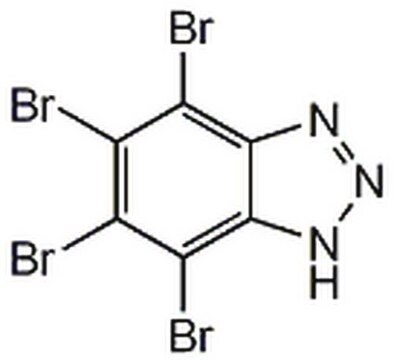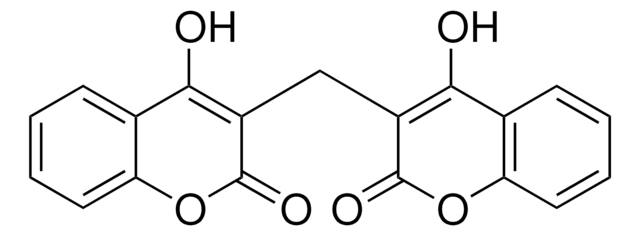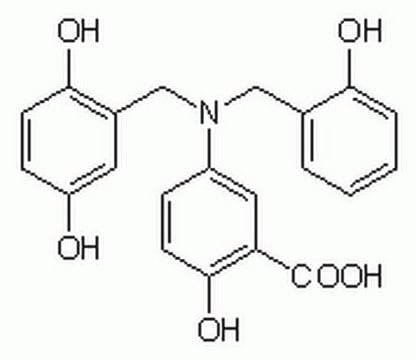287897
Dicoumarol
A cell-permeable quinone reductase inhibitor with anticoagulant properties.
Synonyme(s) :
Dicoumarol, 3,3ʹ-Methylenebis(4-hydroxycoumarin), Bishydroxycoumarin, Dicumarol
About This Item
Produits recommandés
Niveau de qualité
Pureté
≥98% (titration)
Forme
solid
Fabricant/nom de marque
Calbiochem®
Conditions de stockage
OK to freeze
protect from light
Couleur
white
Solubilité
0.1 M NaOH: 15 mg/mL
pyridine: 50 mg/mL
Conditions d'expédition
ambient
Température de stockage
2-8°C
InChI
1S/C19H12O6/c20-16-10-5-1-3-7-14(10)24-18(22)12(16)9-13-17(21)11-6-2-4-8-15(11)25-19(13)23/h1-8,20-21H,9H2
Clé InChI
DOBMPNYZJYQDGZ-UHFFFAOYSA-N
Description générale
Actions biochimiques/physiologiques
Blocks brefeldin A-dependent mono-ADP-ribosylation in vitro
Conditionnement
Avertissement
Reconstitution
Autres remarques
Krause, D., et al. 2001. J. Biol. Chem.276, 19244.
Pink, J.J., et al. 2000. J. Biol. Chem.275, 5416.
Cross, J.V., et al. 1999. J. Biol. Chem.274, 31150.
Morrow, C.S., et al. 1998. J. Biol. Chem.273, 20114.
Weigert, R., et al. 1997. J. Biol. Chem.272, 14200.
Informations légales
Mention d'avertissement
Danger
Mentions de danger
Conseils de prudence
Classification des risques
Acute Tox. 3 Oral - Aquatic Chronic 2 - STOT RE 1 Oral
Code de la classe de stockage
6.1C - Combustible acute toxic Cat.3 / toxic compounds or compounds which causing chronic effects
Classe de danger pour l'eau (WGK)
WGK 3
Point d'éclair (°F)
Not applicable
Point d'éclair (°C)
Not applicable
Certificats d'analyse (COA)
Recherchez un Certificats d'analyse (COA) en saisissant le numéro de lot du produit. Les numéros de lot figurent sur l'étiquette du produit après les mots "Lot" ou "Batch".
Déjà en possession de ce produit ?
Retrouvez la documentation relative aux produits que vous avez récemment achetés dans la Bibliothèque de documents.
Les clients ont également consulté
Notre équipe de scientifiques dispose d'une expérience dans tous les secteurs de la recherche, notamment en sciences de la vie, science des matériaux, synthèse chimique, chromatographie, analyse et dans de nombreux autres domaines..
Contacter notre Service technique












